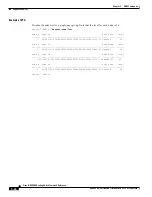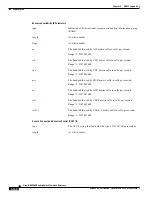
5-87
Cisco MGX 8850 Routing Switch Command Reference
Release 2.0, Part Number 78-10467-04 Rev C0, October 2001
Chapter 5
PNNI Commands
dsppnni-path
dsppnni-path
Display PNNI Path
—
display the pre-computed path tables.
The dsppnni-path command displays the pre-computed paths between the source (the current node) and
the destination nodes. The system has determined these paths to be the best or optimal paths for various
service classes according to one of three metrics. These metrics are the administrative weight (AW), the
cell transfer delay (CTD), or the cell delay variation (CDV). The service class that each metric supports
for the purpose of routing varies. For a list of metrics and service classes, see
Table 5-3
. For
dsppnni-path, you must specify a combinations of routing metric and service class.
You can also specify a node index. If you specify a node-index, the command displays the paths from
the source node to the node whose index you specify. To see a list of node indexes, execute
dsppnni-node-list. (The dsppnni-node-list command displays network-level node indexes under the
heading “node #.”)
Cards on Which This Command Runs
PXM45
Syntax
dsppnni-path {aw {cbr|rtvbr|nrtvbr|ubr|abr} | ctd {cbr|rtvbr|nrtvbr} | cdv {cbr|rtbvr}}
[node-index]
Syntax Description
Note
The mandatory keywords in this command do not take the usual dash that many keywords require.
If you include a dash in front of the keyword, the system rejects the command.
Note
The optional node-index lets you select a specific node in the network whose path connectivity you
want to see. The local node creates the node indexes (or node numbers) according to the sequence
that it discovers its neighbors. You can only provide it as a command parameter or view it in
applicable displays. Whether or not you specify node-index, the node indexes appear in the “node#”
column. (Note that this node index or node# is not the node index that identifies a node within the
hierarchy of a multiple-peer group. See dsppnni-node for details on the local node index.)
Table 5-3
Routing Criteria and Service Classes
Routing Metric
Applicable Service Classes
AW
CBR, ABR, UBR, rt-VBR,
nrt-VBR
CTD
CBR, rt-VBR, nrt-VBR
CDV
CBR, rt-VBR
















































